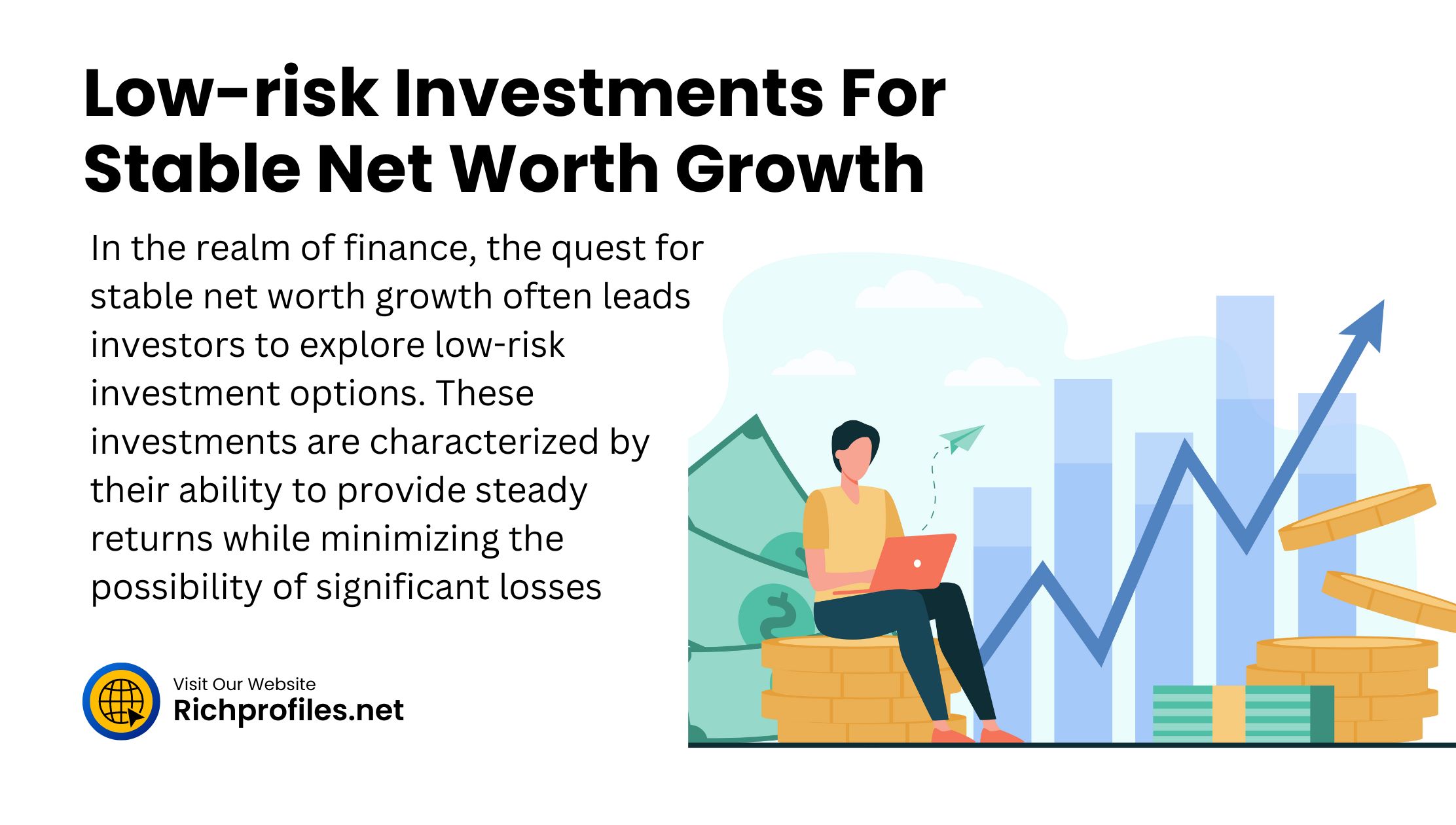Introduction Of Low-Risk Investments For Stable Net Worth Growth
In the realm of finance, the quest for stable net worth growth often leads investors to explore low-risk investment options. These investments are characterized by their ability to provide steady returns while minimizing the possibility of significant losses. In this article, we’ll delve into the world of Low-risk Investments For Stable Net Worth Growth, exploring their benefits, types, strategies, and tips for maximizing returns.
Benefits of Low-Risk Investments
Capital Preservation
One of the primary advantages of low-risk investments is capital preservation. Unlike high-risk ventures, which are susceptible to market volatility, low-risk investments aim to safeguard the initial capital. This feature provides investors with peace of mind, knowing that their principal amount is relatively secure.
Consistent Returns
Low-risk investments offer the allure of consistent returns over time. While the returns may not be as high as those associated with riskier assets, such as stocks, they tend to be more predictable and stable. This predictability enables investors to plan for their financial future with greater certainty.
Lower Stress and Anxiety
Investing in low-risk instruments can alleviate the stress and anxiety often associated with volatile markets. By opting for safer alternatives, investors can minimize the emotional rollercoaster ride of watching their portfolios fluctuate wildly. This psychological benefit is invaluable, especially during periods of economic uncertainty.
Types of Low-Risk Investments
Government Bonds
Government bonds are considered among the safest investments available. Backed by the full faith and credit of the issuing government, these bonds provide a fixed rate of interest over a specified period. Treasury bonds, notes, and bills are popular options for investors seeking stability and income.
High-Yield Savings Accounts
High-yield savings accounts, typically offered by banks and credit unions, offer a safe haven for cash reserves. They provide higher interest rates than traditional savings accounts. While the returns may be modest, the principal amount is FDIC-insured, providing an added layer of security.
Certificate of Deposits (CDs)
Certificates of Deposit (CDs) are time deposits offered by banks and financial institutions. Investors deposit funds for a predetermined period, during which they earn a fixed rate of interest. CDs are known for their low risk and guaranteed returns, making them a popular choice for risk-averse individuals.
Dividend-Paying Stocks
Dividend-paying stocks represent shares of companies that distribute a portion of their profits to shareholders in the form of dividends. While stocks inherently carry more risk than bonds or savings accounts, dividend-paying companies with established track records offer a measure of stability and income potential.
Real Estate Investment Trusts (REITs)
Real Estate Investment Trusts (REITs) allow investors to gain exposure to the real estate market without directly owning physical properties. These investment vehicles pool funds from multiple investors to invest in a diversified portfolio of income-generating properties. REITs offer stable dividends and the potential for long-term capital appreciation.
Factors to Consider When Choosing Low-Risk Investments
Risk Tolerance
Understanding one’s risk tolerance is crucial when selecting low-risk investments. While some investors prioritize safety above all else, others may be willing to accept slightly higher risk for potentially higher returns. Assessing risk tolerance helps investors align their investment choices with their financial goals and comfort levels.
Investment Goals
Investment goals vary from individual to individual and may include objectives such as wealth preservation, income generation, or capital growth. By clearly defining their investment goals, investors can tailor their portfolios to meet their specific needs and aspirations.
Time Horizon
The time horizon refers to the length of time an investor intends to hold an investment before needing to access the funds. Low-risk investments are well-suited for short to medium-term goals, where capital preservation is paramount. Investors with longer time horizons may incorporate a mix of low-risk and higher-risk assets to balance stability and growth potential.
Liquidity Needs
Liquidity needs must be considered when choosing low-risk investments. While some assets offer immediate access to funds, others may impose restrictions or penalties for early withdrawals. Investors should evaluate their liquidity requirements and choose investments that align with their cash flow needs.
Read More: Net Worth Outcomes From Investing In Education: Guide 2024
Strategies for Building a Diversified Portfolio with Low-Risk Investments
Asset Allocation
Asset allocation involves dividing investment funds among different asset classes, such as stocks, bonds, and cash equivalents. By diversifying across various asset categories, investors can spread risk and enhance portfolio stability. A well-balanced asset allocation strategy is critical to mitigating volatility and achieving long-term financial objectives.
Dollar-Cost Averaging
Dollar-cost averaging is a systematic investment strategy that involves investing a fixed amount of money at regular intervals, regardless of market conditions. This approach allows investors to purchase more shares when prices are low and fewer shares when prices are high, ultimately reducing the average cost per share over time.
Reinvesting Dividends
Reinvesting dividends can accelerate wealth accumulation in low-risk investments. Instead of receiving dividends as cash payouts, investors have the option to reinvest them back into the investment vehicle, thereby compounding their returns. Over time, the power of compounding can significantly enhance the growth of investment portfolios.
Tips for Maximizing Returns on Low-Risk Investments
Research and Due Diligence
Thorough research and due diligence are essential when evaluating low-risk investment options. Investors should carefully assess the creditworthiness of bond issuers, the financial health of dividend-paying companies, and the underlying assets of REITs. By conducting comprehensive research, investors can make informed decisions and mitigate the risk of potential losses.
Avoiding High Fees
High fees can erode returns and diminish the benefits of low-risk investments. When selecting investment products, investors should be mindful of management fees, commissions, and other expenses that may impact their overall returns. Opting for low-cost investment options can maximize net returns and enhance long-term wealth accumulation.
Monitoring and Adjusting
Regular monitoring and adjustment of investment portfolios are essential for maintaining optimal performance. Economic conditions, market trends, and personal circumstances may change over time, necessitating periodic reviews and adjustments to asset allocations. By staying informed and proactive, investors can adapt to evolving market dynamics and preserve their financial well-being.
Conclusion
In conclusion, low-risk investments play a crucial role in achieving stable net worth growth and financial security. By prioritizing capital preservation, embracing diversification, and adhering to sound investment principles, investors can build resilient portfolios capable of weathering market fluctuations. Whether through government bonds, savings accounts, dividend stocks, or REITs, low-risk investments offer a path to long-term prosperity and peace of mind.
FAQs
What are the best low-risk investments for beginners?
For beginners, high-yield savings accounts and government bonds are excellent options due to their simplicity and safety.
How can I minimize risk while investing in stocks?
To minimize risk when investing in stocks, focus on dividend-paying companies with solid fundamentals and a history of stable earnings.
Are low-risk investments suitable for short-term goals?
Yes, low-risk investments are well-suited for short-term goals, such as building an emergency fund or saving for a down payment on a house.
Can low-risk investments outperform high-risk ones in the long run?
While low-risk investments typically offer lower returns than high-risk ones, they can outperform in the long run due to their consistency and stability.
What role does inflation play in low-risk investments?
Inflation can erode the purchasing power of low-risk investments over time. To preserve real wealth, it’s essential to choose investments that offer returns exceeding the inflation rate.




